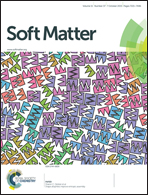Nanoparticle stability in biologically relevant media: influence of polymer architecture†
Abstract
We have contrasted the behavior of nanoparticles formed by the self-assembly of polymers based on poly(ethylene glycol) (PEG) and poly(D,L-lactide), with linear, linear-dendritic and bottle-brush architectures in biologically relevant media. Polymer PEG content ranged between 14% and 46% w/w, and self-assembly was triggered by a rapid and large change in solvent quality inside a four-stream vortex mixer. We examined nanoparticle interaction with human serum albumin (HSA), and solute release in the presence of fetal bovine serum. Dynamic light scattering data showed that PEG surface brushes of all nanoparticles provided effective steric stabilization, thus limiting their interaction with human serum albumin. Calorimetric experiments revealed that nanoparticle–HSA interaction was relatively weak and enthalpically driven, whereas dynamic light scattering results of incubated nanoparticles showed the absence of larger aggregates for most of the polymers examined. Solute core partitioning was examined by the loss of Forster resonance energy transfer (FRET) from a core-loaded donor–acceptor pair. The rate and magnitude of FRET efficiency loss was strongly dependent on the polymer architecture, and was found to be lowest for the bottle-brush, attributed to its covalent nature. Collectively, these findings are expected to impact the molecular design of increasingly stable polymeric carriers for drug delivery applications.


 Please wait while we load your content...
Please wait while we load your content...